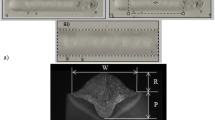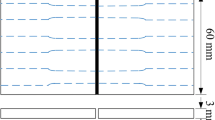Abstract
Because of the relativity among the parameters, partial least square regression (PLSR) was applied to build the model and get the regression equation. The improved algorithm simplified the calculating process greatly because of the reduction of calculation. The orthogonal design was adopted in this experiment. Every sample had strong representation, which could reduce the experimental time and obtain the overall test data. Combined with the formation problem of gas metal arc weld with big current, the auxiliary analysis technique of PLSR was discussed and the regression equation of form factors (i. e. surface width, weld penetration and weld reinforcement) to process parameters(i. e. wire feed rate, wire extension, welding speed, gas flow, welding voltage and welding current) was given. The correlativity structure among variables was analyzed and there was certain correlation between independent variables matrix X and dependent variables matrix Y. The regression analysis shows that the welding speed mainly influences the weld formation while the variation of gas flow in certain range has little influence on formation of weld. The fitting plot of regression accuracy is given. The fitting quality of regression equation is basically satisfactory.
Similar content being viewed by others
References
XIONG Zheng-yu, ZHANG Hua. Research on the geometry parameters of weld seam in Ar+CO2 mixed gas arc welding[J]. Journal of Nanchang University(Engineering & Technology), 2001,23(4):40–44. (in Chinese)
FEN Wei, YANG Xian-hui. The quality correlation analysis and modelling of atmospheric distillation unit based on PCA and PLS onit[J]. Petrochemical Technology, 1997, 4(3): 160–164. (in Chinese)
FEN Wei, YANG Xian-hui. Statistical correlation analysis and modeling in quality control[J]. Journal of Tsinghua University (Science & Technology), 1998, 38(9): 63–66. (in Chinese)
WANG Yang. Application of PLS regression [J]. Journal of Anhui University(Natural Science Edition), 2001, 25(3): 18–23. (in Chinese)
QU Hai-bin. Modeling method based on PLS [J]. Journal of Zhejiang University (Engineering Science), 1999, 33(5): 471–474. (in Chinese)
WANG Hui-wen. Partial Least Squares Regression—Method and Applications[M]. Beijing: National Defence Industry Press, 1999. (in Chinese)
Wentzell P D, Montoto L V. Comparison of principal components regression and partial least squares regression through generic simulations of complex mixtures [J]. Chemometrics and Intelligent Laboratory Systems, 2003, 65(2): 257–279.
Kemsley E K. Discriminant analysis of high-dimensional data:a comparison of principal components analysis and partial least squares data reduction methods [J]. Chemometrics and Intelligent Laboratory Systems, 1996, 33(1): 47–61.
LUO Pi, GUO Ji-chang, LI Qiang, et al. Modeling construction based on partial least squares regression [J]. Journal of Tianjin University, 2002, 35(6): 783–786. (in Chinese)
WEN Zhong, YU Jin-shou, HA Xiang-ming. An application of nonlinear partial least square in catalyst activity modeling[J]. Journal of East China University of Science and Technology, 1998, 24(6): 717–721. (in Chinese)
JIANG Hong-wei, XIA Jie-lai. Partial least square and its application[J]. Journal of Fourth Military Medical University, 2003, 24(3): 280–283. (in Chinese)
Helland I S. Some theoretical aspects of partial least squares regression[J]. Chemometrics and Intelligent Laboratory Systems, 2001, 58(2): 97–107.
Wold S, Trygg J, Berglund A, et al. Some recent developments in PLS modeling [J]. Chemometrics and Intelligent Laboratory Systems, 2001, 58(2): 131–150.
Ruscio D D. A weighted view on the partial least squares algorithm [J]. Automatica, 2000, 36 (6): 831–850.
Malthouse E C, Tamhane A C, Mah R S H. Nonlinear partial least squares[J]. Computers & Chemical Engineering, 1997, 21(8): 875–890.
LI Bai-bing, Morris J, Martin E B. Model selection for partial least squares regression[J]. Chemometrics and Intelligent Laboratory Systems, 2002, 64(1): 79–89.
Author information
Authors and Affiliations
Corresponding author
Rights and permissions
About this article
Cite this article
Yang, Hl., Cai, Y., Bao, Yf. et al. Analysis and application of partial least square regression in arc welding process. J Cent. South Univ. Technol. 12, 453–458 (2005). https://doi.org/10.1007/s11771-005-0181-z
Received:
Accepted:
Published:
Issue Date:
DOI: https://doi.org/10.1007/s11771-005-0181-z




